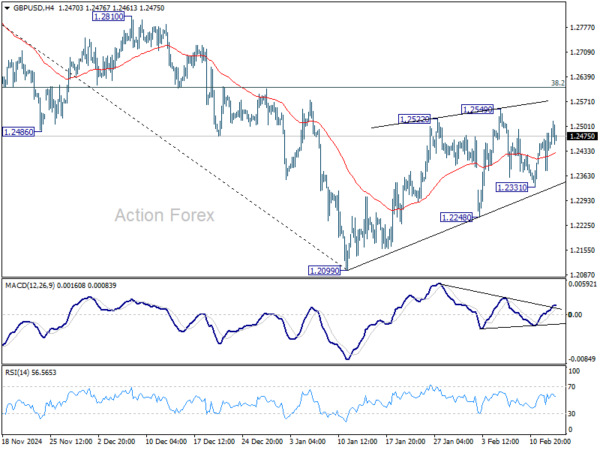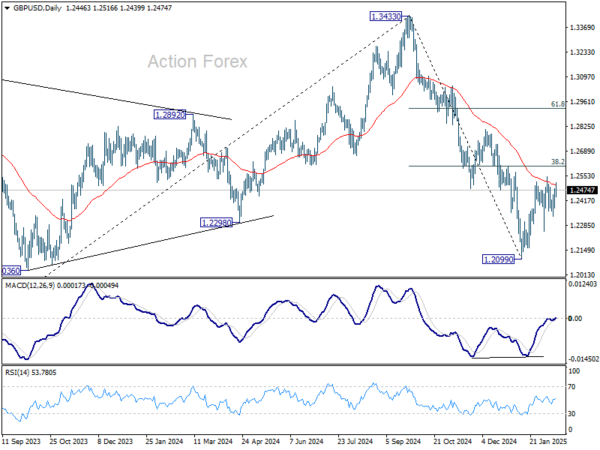Dollar Muted Despite Strong PPI, Awaits Reciprocal Tariffs
The currency markets are treading cautiously, with traders showing little reaction to stronger-than-expected US PPI data and a better-than-anticipated jobless claims report. Despite these inflationary signals, Dollar has struggled to gain further traction, as market participants hold their positions ahead of a highly anticipated announcement on US “reciprocal tariffs” from President Donald Trump. The announcement, expected later today in a news conference at the Oval Office, could provide a clearer picture of how US trade policy will evolve and its impact on global markets.
While Fed’s restrictive stance on interest rates remains intact, this week’s hot CPI and PPI data suggest that inflation is proving more persistent than policymakers had hoped. Chair Jerome Powell has already reinforced that Fed is in no hurry to cut rates, and expectations for rate reductions in the first half of the year have now diminished. Market focus will now shift to upcoming US retail sales figures and additional comments from Fed officials, as traders assess how these data points might influence the central bank’s next policy moves.
Sterling briefly found some boost after stronger-than-expected UK GDP data, which helped ease immediate concerns over a recession. However, the currency’s gains were short-lived, as investors remain cautious about the country’s sluggish economic outlook. While BoE has signaled a path of gradual easing, the market are more conservative than BoE guidance, with traders still pricing in just two rate cuts before year-end. Given the uncertainty around inflation and growth, the pace of BoE rate cuts will remain a key point of debate in the coming months.
For the day, Swiss Franc leads currency gains as Japanese Yen follows behind, while Sterling holds firm too. On the weaker end, Australian and New Zealand Dollars are struggling. Dollar, despite its inflation-fueled rally earlier in the week, has lost momentum, as traders await further trade policy developments. Euro and Canadian Dollar are stuck in the middle of the pack.
In Europe, at the time of writing, FTSE is down -0.56%. DAX is up 1.64%. CAC is up 1.40%. UK 10-year yield is down -0.045 at 4.493. Germany 10-year yield is down -0.050 at 2.431. Earlier in Asia, Nikkei rose 1.28%. Hong Kong HSI fell -0.20%. China Shanghai SSE fell -0.42%. Singapore Strait Times rose 0.21%. Japan 10-year JGB yield rose 0.0028 to 1.350.
US PPI up 0.3% mom, 3.5% yoy in Jan, above expectations
US PPI for final demand rose by 0.4% mom in January, exceeding market expectations of 0.2% mom.
Final demand services increased by 0.3% mom, while final demand goods rose by 0.6% mom. Core PPI measure, which strips out volatile food, energy, and trade services, climbed 0.3% mom.
On an annual basis, headline PPI accelerated to 3.5% yoy, surpassing forecasts of 3.2% yoy. Core PPI followed closely, advancing 3.4% yoy.
US initial jobless claims falls to 213k vs exp 221k
US initial jobless claims fell -7k to 213k in the week ending February 8, below expectation of 221k. Four-week moving average of initial claims fell -1k to 216k.
Continuing claims fell -36k to 1850k in the week ending February 1. Four-week moving average of continuing claims fell -1k to 1872k.
Eurozone industrial production falls -1.1% mom in Dec, EU down -0.8% mom
Eurozone industrial production fell by -1.1% mom in December, significantly worse than the market expectation of -0.6% mom. The decline was driven by sharp contractions in intermediate and capital goods, while non-durable consumer goods provided some offset.
Breaking down the data, intermediate goods production declined by -1.9% mom. The production of capital goods fell even further, down -2.6% mom. Durable consumer goods also posted a modest decline of -0.7% mom. On the other hand, energy production rose by 0.5% mom, and non-durable consumer goods surged by 5.1% mom.
At the broader EU level, industrial production contracted by -0.8% mom, with Belgium (-6.8%), Portugal (-4.4%), and Austria (-3.3%) suffering the steepest declines. Meanwhile, Ireland (+8.2%), Luxembourg (+6.7%), and Croatia (+6.3%) posted strong rebounds.
Swiss inflation softens again as CPI slows to 0.4% in Jan
Switzerland’s CPI declined by -0.1% mom in January, in line with market expectations. Core CPI, which excludes fresh and seasonal products, energy, and fuel, also dropped by -0.1% mom. While domestic product prices ticked up by 0.1% mom, the steep -0.7% mom decline in imported product prices suggests that external factors continue to exert deflationary pressure on the Swiss economy.
On a year-over-year basis, headline inflation eased from 0.6% yoy to 0.4% yoy, also matching expectations. However, core CPI edged higher to 0.9% yoy from 0.7% yoy. Domestic product inflation slowed from 1.5% yoy to 1.0% yoy, reflecting weaker demand and subdued price pressures in the local economy. Meanwhile, imported product prices remained in deflationary territory, improving slightly from -2.2% yoy to -1.5% yoy.
UK GDP surprises to the upside, services lead the growth
The UK economy outperformed expectations in December, with GDP expanding by 0.4% mom, significantly stronger than the 0.1% growth forecast. The services sector led the way, posting 0.4% monthly growth, while production output also rebounded, rising by 0.5%. However, the construction sector remained weak, contracting -0.2% mom.
For Q4 as a whole, GDP increased by 0.1% qoq, defying expectations for a -0.1% contraction. Services grew by 0.2% in Q4, maintaining its position as the primary growth driver, while construction saw a moderate expansion of 0.5%. However, industrial production was a notable drag, shrinking by -0.8%.
For full-year 2024, GDP increased by 0.8% compared to 2023, a modest but better-than-feared outcome given the economic uncertainties. Services expanded by 1.3%, cushioning the economy, while production sector contracted by -1.7%, and construction grew slightly by 0.4%.
RBNZ survey shows rate cut expectations firm up
The latest RBNZ Survey of Expectations showed a mixed shift in inflation forecasts, with short-term price pressures edging higher but long-term expectations trending lower. The survey, nonetheless, reinforces anticipation of further rate cuts.
One-year-ahead inflation expectation rose from 2.05% to 2.15%, marking a slight uptick. However, two-year-ahead inflation expectations dipped from 2.12% to 2.06%, while five-year and ten-year expectations both declined by 11-12 basis points to 2.13% and 2.07%, respectively.
RBNZ’s Official Cash Rate currently stands at 4.25% following 50bps reduction in last November. Survey respondents broadly expect another 50-bps cut to 3.75% by the end of Q1. The one-year-ahead OCR expectation also moved lower, falling 10bps to 3.23%, reinforcing the view that RBNZ will continue easing policy at a measured pace.
GBP/USD Mid-Day Outlook
Daily Pivots: (S1) 1.2387; (P) 1.2435; (R1) 1.2493; More…
Outlook in GBP/USD is unchanged and intraday bias stays neutral. Corrective rebound from 1.2099 could still extend higher. But upside should be limited by 38.2% retracement of 1.3433 to 1.2099 at 1.2609. On the downside, below 1.2331 minor support will turn bias to the downside for 1.2248 support. Firm break there will argue that the correction has completed and bring retest of 1.2099 low. However, decisive break of 1.2609 will raise the chance of near term reversal, and target 61.8% retracement at 1.2923.
In the bigger picture, rise from 1.0351 (2022 low) should have already completed at 1.3433 (2024 high), and the trend has reversed. Further fall is now expected as long as 1.2810 resistance holds. Deeper decline should be seen to 61.8% retracement of 1.0351 to 1.3433 at 1.1528, even as a corrective move. However, firm break of 1.2810 will dampen this bearish view and bring retest of 1.3433 high instead.
The Penny Drops: Understanding The Complex World Of Small Stock Machinations
Micro-cap stocks, often overlooked by mainstream investors, have recently garnered significant attention due to rising c... Read more
Current Economic Indicators And Consumer Behavior
Consumer spending is a crucial driver of economic growth, accounting for a significant portion of the US GDP. Recently, ... Read more
Skepticism Surrounds Trump's Dollar Devaluation Proposal
Investors and analysts remain skeptical of former President Trump's dollar devaluation plan, citing tax cuts and tariffs... Read more
Financial Markets In Flux After Biden's Exit From Presidential Race
Re-evaluation of ‘Trump trades’ leads to market volatility and strategic shifts.The unexpected withdrawal of Joe Bid... Read more
British Pound Poised For Continued Gains As Wall Street Banks Increase Bets
The British pound is poised for continued gains, with Wall Street banks increasing their bets on sterling's strength. Th... Read more
China's PBoC Cuts Short-Term Rates To Stimulate Economy
In a move to support economic growth, the People's Bank of China (PBoC) has cut its main short-term policy rate for the ... Read more



